trlvn
Ultra Member
For no good reason, I picked up a weird little gizmo on the weekend...a mini, user-made indexer.

Next to the worm gear 'teeth', you can make out that it is marked regularly around the circumference. There are 48 divisions so it easy enough to divide into 2, 3, 4, 6, 8, 12, 24 or (of course) 48 parts. There is a sping-loaded wedge that clicks into the small notched wheels next to the knurled knob. These give decent registration (and more!).
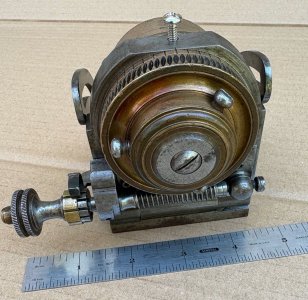
The spring-loaded wedge can be adjusted to engage either the larger brass notched wheel (8 notches) or the smaller steel version (12 notches).
I believe the worm ratio is 90:1. It isn't easy to count as there is not a mark on the knob to easily see full turns. I did note, however, that it takes 15 clicks on the 8 notch wheel to advance one marked division or 1/48 th turn. (15/8 X 48 = 90) Thus it takes 720 clicks on the 8-notch wheel for a full rotation or 1 click equals 1/2 a degree! Using the 12-notch wheel means 1 click is 1/3 of a degree.
With the worm ratio, the notched wheels effectively act like different rows of holes in a more-typical dividing head plate. One could even make custom notched wheels to achieve additional dividing combinations.
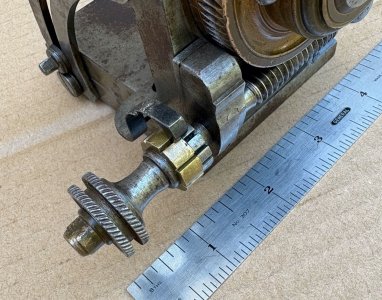
The problem, though, is the work-holding side:
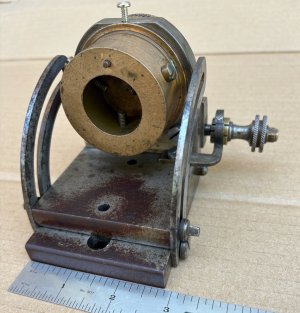
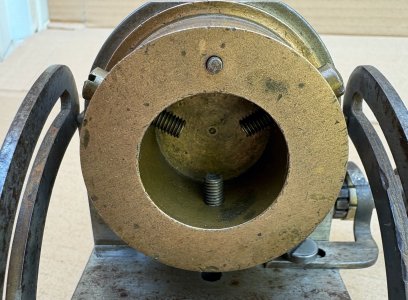
The hole is about 1.170 diameter by 0.849 inches deep. Not exactly standard for anything I'm familiar with. No through hole, either. I think it might be possible to adapt it to use, say, ER16 or ER20 collets. Not sure I want to go to that trouble.
Finally, it can be set up an angle from horizontal:
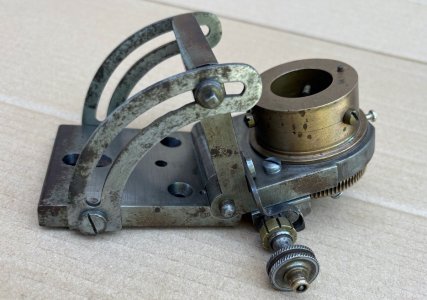
It can't go quite to 90 degrees due to built in stops in the hinge.
Overall, I'm puzzled about this thing. It is clearly user-made and took some very careful and skillful work to build. But the work-holding side seems beyond crude by comparison.
Would this have been an assignment for an apprentice? I thought that such projects were usually to make something that the builder could continue to use throughout their career? Or is it maybe for some specialized trade?
Thoughts?
Craig T.

Next to the worm gear 'teeth', you can make out that it is marked regularly around the circumference. There are 48 divisions so it easy enough to divide into 2, 3, 4, 6, 8, 12, 24 or (of course) 48 parts. There is a sping-loaded wedge that clicks into the small notched wheels next to the knurled knob. These give decent registration (and more!).

The spring-loaded wedge can be adjusted to engage either the larger brass notched wheel (8 notches) or the smaller steel version (12 notches).
I believe the worm ratio is 90:1. It isn't easy to count as there is not a mark on the knob to easily see full turns. I did note, however, that it takes 15 clicks on the 8 notch wheel to advance one marked division or 1/48 th turn. (15/8 X 48 = 90) Thus it takes 720 clicks on the 8-notch wheel for a full rotation or 1 click equals 1/2 a degree! Using the 12-notch wheel means 1 click is 1/3 of a degree.
With the worm ratio, the notched wheels effectively act like different rows of holes in a more-typical dividing head plate. One could even make custom notched wheels to achieve additional dividing combinations.

The problem, though, is the work-holding side:


The hole is about 1.170 diameter by 0.849 inches deep. Not exactly standard for anything I'm familiar with. No through hole, either. I think it might be possible to adapt it to use, say, ER16 or ER20 collets. Not sure I want to go to that trouble.
Finally, it can be set up an angle from horizontal:

It can't go quite to 90 degrees due to built in stops in the hinge.
Overall, I'm puzzled about this thing. It is clearly user-made and took some very careful and skillful work to build. But the work-holding side seems beyond crude by comparison.
Would this have been an assignment for an apprentice? I thought that such projects were usually to make something that the builder could continue to use throughout their career? Or is it maybe for some specialized trade?
Thoughts?
Craig T.
